Neck exercises can be a really important part of your strategy to relieve and prevent headaches.
There are simple exercises for headache relief that can make a significant contribution to treating headache pain.
Neck exercises are also useful in maintaining improvements and prevention after treatment of headaches and migraine.
Here are our 5 favourite exercises to relieve headache pain.
These are followed by our least favourite exercise, which happens to be the most common one given by physio, chiros and the YouTube …
Our favourite exercises to relieve headache pain
1. Cervical retraction
Purpose:
- neck mobility for all of the neck, including upper thoracic spine
- reversal from the forward head position
Also used in selected patients for:
- headache and migraine reduction
- neck pain and neck-related arm pain and other symptoms
Cervical retraction is also known as ‘chin slides’ or ‘chin tucks’.
It is the exercise we test and prescribe most often to help our patients manage their headaches or migraines.
The challenge with retraction is performing it correctly.
The key is that it should be a translation of the skull backwards as far as possible, without looking up or down.
I’d suggest running through retraction with a physiotherapist first because it is worth:
- determining if it is the right movement for you
- working out the variations that give you the best result
- ensuring your technique is correct is important to not only give you the best result, but to avoid creating neck pain or worsening headaches
- exploring whether you will get the best result with repeated movements or a sustained hold.
When done correctly and with the right person, retraction can be a very effective and even life-changing exercise.
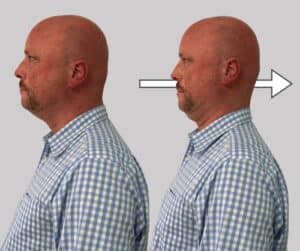
2. Shoulder blade (scapular) retraction
Purpose:
- activate shoulder blade muscles
- bring awareness to posture
- reset posture
For headache sufferers, static posture and sustained postures can play a big part in creating or maintaining the a headache or neck pain problem.
A common posture is shoulders rounded and chin is poking forward.
Working at a computer or being on a mobile phone encourages this kind of position.
The shoulder blade retraction position helps to counter this position. It also helps you to be more aware of your whole body posture too.
It makes a huge difference when you start from a position of being ‘as tall as you can be’.
Then think about making your collarbones ‘as wide as they can be’.
By doing this, you will be drawing your shoulder blades back and placing them in a more natural position. You don’t want to overdo it and have your shoulder blades squeezed together, or pulled down.
Just natural.
Combine this with being ‘as tall as you can be’ and it will naturally bring your neck into a more neutral position.
This occasional adjustment of posture can be a quick and helpful way of managing headaches or migraines when postural factors are important.
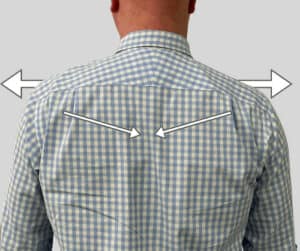
3. Head nods
- reduce stiffness of the neck
- help activate deep flexor muscles of the neck
This movement is more accurately known as ‘cranio-cervical flexion’.
It is quite a small movement of the head on the neck, and it usually doesn’t feel like much.
But it has a number of benefits in headache relief and prevention.
Head nods can be performed lying on your back with a towel or a chi ball under the neck. It can also be done standing up.
It is a small range movement of just your skull, not your neck.
It means that the first joint between your skull and the first vertebra C1 gets the benefit of the movement.
All of the associated soft tissues also get some great movement and gentle stretch.
It also requires your deep neck flexor muscles to create the movement, which are an important group of muscles for support of your neck.
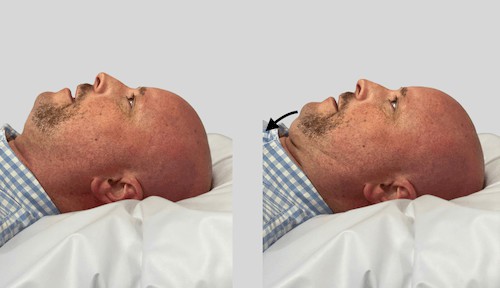
4. Cervical rotation
Purpose:
- neck mobility for healthy neck joints and muscles.
It is surprising how easy it is to go through a day without taking your neck through its full range of movement.
You might momentarily turn to check your blind spot, but your joints crave more than that to stay fully functional.
Neck rotation to your limit towards the left and the right, done slowly and intentionally, is a great way to keep this movement as free as possible.

5. Thoracic extension
Purpose:
- flexibility of the thoracic spine is needed for neck and shoulder movement and range of movement
- thoracic mobility is important for headache management
Thoracic spine flexibility is important for many neck and headache problems, as well as thoracic spine pain.
Thoracic stiffness is common in people with headaches and migraines.
Reduced thoracic mobility creates a limitation in available neck range. It also limits your ability to easily achieve a good thoracic and cervical spine position.
Below are two thoracic extension stretches that are both lying over a rolled up towel. You can easily do these on a foam roller too.
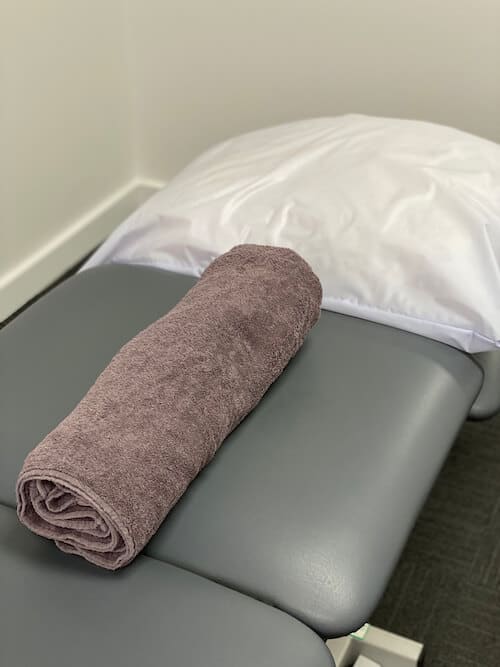
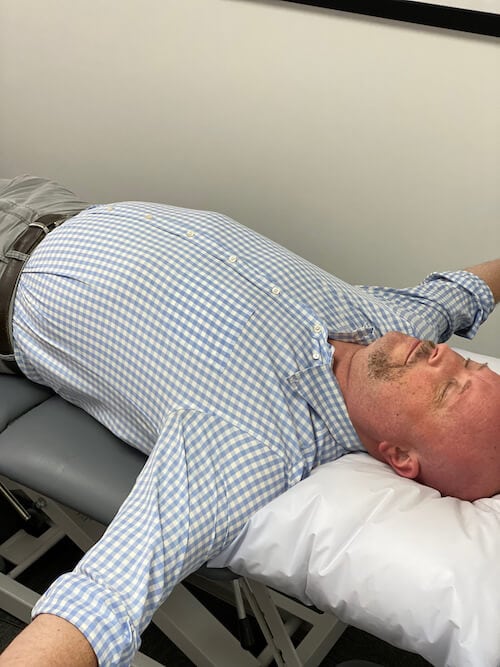
The exercise above is with the rolled towel lengthwise along the spine, allowing an easy way of stretching the front of the shoulders.
Below, the rolled towel is perpendicular to the spine, and it demonstrates how you can use shoulder flexion to accentuate the thoracic extension stretch.
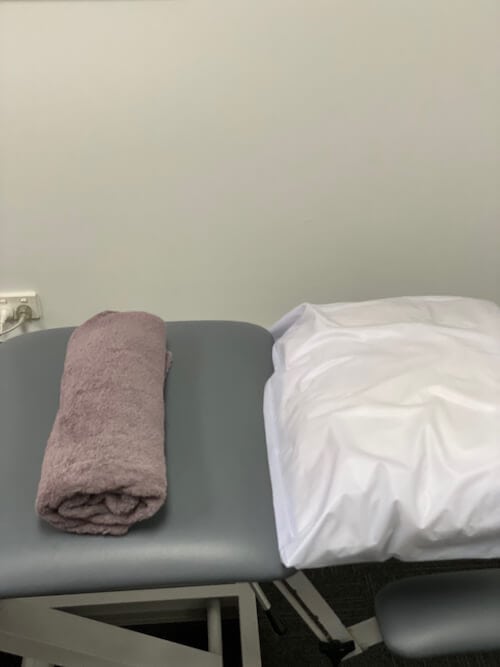
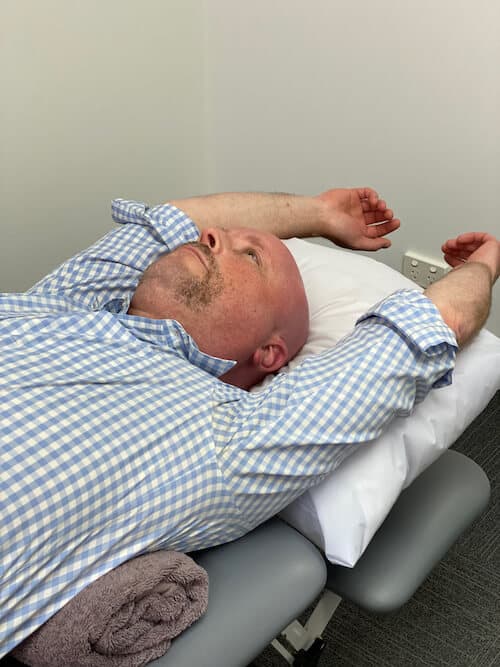
The one neck stretch exercise that we don't use
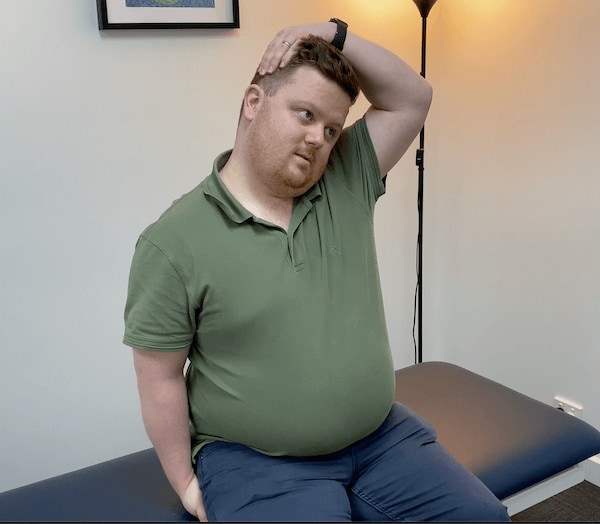
This is a stock standard stretch that is given out by physios, chiros and others for people with headaches and neck pain. It happens to be one that none of us give out!
It’s supposed to be a stretch for upper trapezius or levator scapulae.
Over the years, we have found that it isn’t all that it’s cracked up to be.
It’s not that it’s bad, it’s just that it doesn’t help much.
And there are more useful exercises for the person that has tight or stiff neck muscles or feel like they have ‘tight upper traps’.
Usually upper trapezius and levator scapulae are not the problem, but are the culprit.
There are more important things to look at, like a protracted scapular position or endurance of these muscles.
Read more about our headache clinic
We understand the dilemma of headache and migraine sufferers better than anyone.
Click to read this page about what can we offer you and how we go about it.
Hopefully you’ll see that we are not your average physio service!
How can I use these simple exercises for headache relief?
If you are looking for a multi-pronged DIY approach for helping your headaches, neck exercises and postural awareness should be an essential part of your strategy.
A number of our patients use retraction as first line treatment when a headache or a migraine starts to grumble.
If it is done correctly, and with enough repetitions and sustain, it can replace their need to take preventative medication.
Not for everyone, but enough people to make it worth trying out.
My suggestion would be to do a dedicated 4 weeks of concentrating on these exercises, combined with regular position change in your work or recreation.
If you are trying to improve your headaches on your own, I would make other lifestyle modifications too.
These should include general aerobic exercise, optimising your diet, exploring meditation or other forms of stress management, and a medication review with your GP.
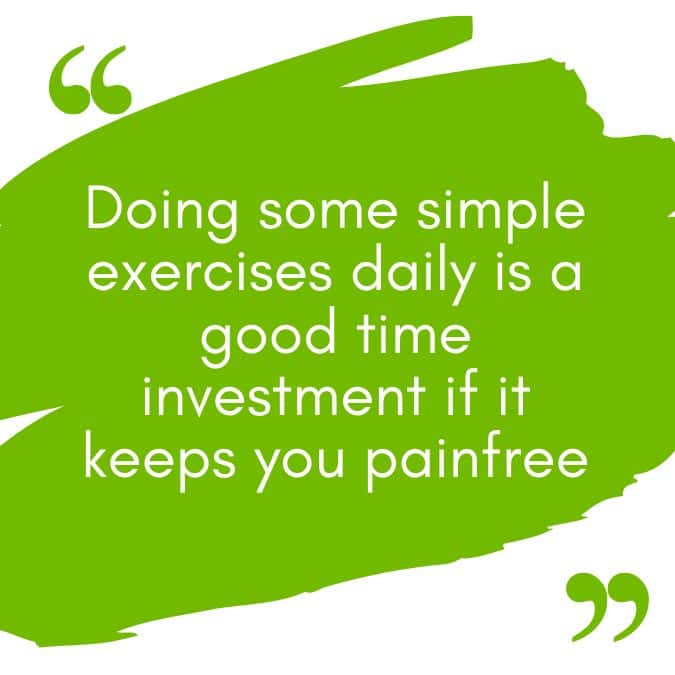
How often should I do these exercises to get optimal relief?
There are two aspects to exercise for headaches: treatment and prevention.
For treatment of headaches, it is about reducing their
- frequency
- intensity
- impact on life
and ideally stopping them when they happen.
In this phase, we find that doing exercise more frequently is useful, like four times a day, plus plenty of position changes.
Prevention is more like a maintenance phase. This usually means a less aggressive use of the exercises.
For prevention of headaches, these exercises can make up a 5 to 10 minute routine that is done twice a day for prevention.
What should I do if they don't help?
If you have regularly done this routine of simple exercises for headache relief for a month and there is no change to your headache status, it doesn’t mean that your neck isn’t the problem, or a part of the problem.
It usually means one of the following:
- the exercises aren’t targeted enough for you
- the dosage isn’t enough, either in intensity or frequency
- there are other aspects than your neck that are bigger contributors to your problem
- your neck isn’t involved
The next step should be a assessment by a physio skilled in headache and migraine problems.
It may be that your cervical spine isn’t an important factor to your headache problem, but I would never conclude that just because these exercises don’t make a change.
Final words
This article presents our five favourite simple exercises for headache relief.
But there is one thing that we haven’t mentioned that is critical to your success.
Move!
Avoid being stuck in one position and doing one task for long periods of time.
Our bodies crave movement.
They never do well if they are in the same positions for long periods of time, day in and day out.
Please keep in mind, this is a broad discussion about neck stretches for headache relief, and it is important to remember that everyone’s needs are different.
Your headaches might have nothing to do with your neck, and in that case you won’t be doing any harm by doing these exercises, but you might not be getting the result you expect.
The best way to get individualised, targeted exercises is to have your headache or migraine situation assessed by a physio skilled in this type of work.
Would you like to speak a physio free of charge?
Are your headaches holding you back? Let’s talk about it!
BOOK ONLINE or call us on 8356 1000 and let’s lock in a time!
NB: This offer is for Adelaide residents only.














